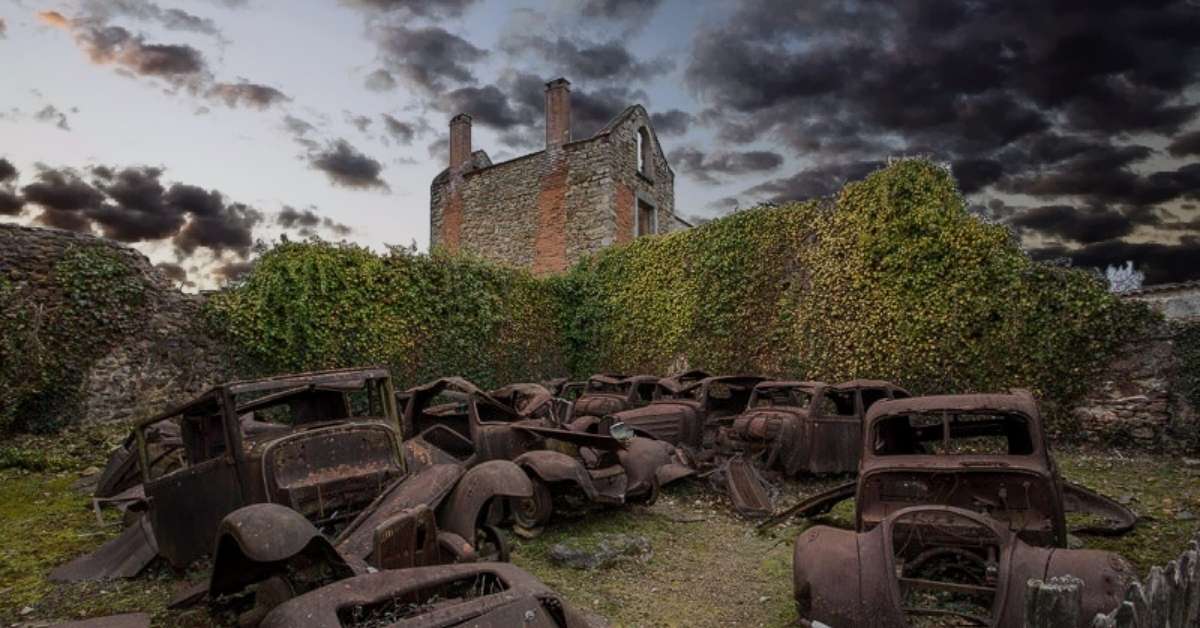This post contains affiliate links, meaning I get a commission if you decide to make a purchase through my links, at no cost to you. Please read my disclosure page for more details.
Category: French History
This episode features our frequent and very popular guest Elyse Rivin. If you enjoy her episodes, please consider supporting her on Patreon.
We've talked about horrible events of the past before on the podcast. But today we discuss a fairly recent terrible event: the fate of Oradour-sur-Glane at the end of WW2.
This article lists hundreds of other French villages where innocent people were also murdered during WW2. The difference with Oradour is that everything was left intact and preserved as a place of memory.
To understand this time period in French history we recommend you also watch Un Village Français.
Oradour-sur Glane was destroyed and rebuilt a few hundred meters away from where the population was martyred. The memorial villages is open every day from 9 AM until 6 PM and you have to pay a few euros to enter.
The city of Limoges nearby is not very touristy but is famous for its porcelain production. There are pretty villages nearby, perhaps we'll do an episode on those at some point. It is best to rent a car to get around in this part of France. You can read Elyse's full notes by clicking on Show Notes below.
A Brief History of Oradour-sur-Glane
The village was surrounded by farmland and forests. Before the massacre there were about 1600 people living in and around the village. Despite the small size, there used to be a tramway to take villagers to Limoges because there weren't enough private cars back then.
There used to be quite a few maquisards (aka resistants) in the area, but none in Oradour per se. It was a peaceful place that kept out of the war as much as possible. There were rumors of an ammunition depot, but that was not the case.
June 10, 1944
In June 1944 as the war was ending, there was a battalion of the SS stationed in Montauban. Then June 6 and 7 and the invasion of Normandy changed the game. Many battalions were ordered to move north and this is how this group of SS found themselves in Oradour.
They had orders to make an example of villages to spread terror in the minds of people. The aim was to frighten French people from helping the resistance in any way.
When the SS arrived they rounded up every person they could find in the center of the village. The pretext was to check their identity to make sure they were really French.
They separated the men from the women. They put the men into 6 groups, they sent them off with soldiers into enclosed spaces where they could not escape and they shot them.
The women, children and elderly were put into the church. Their intention was to gas them, but it didn't work so they set the church on fire instead.
When this was done they went from house to house looking for anyone who was still alive and killed them. They destroyed the cars so nobody could escape. 643 innocent people died that day and 25% of them were children.
A Few Survivors Witness to the Horror
There were 7 male survivors, eventually 6 only because one died from his injuries. One woman survived the church and was able to be a witness at the trial. One man still survives to this day. His name is Robert Hébras.
The massacre of Oradour-sur-Glane took place on June 10th, 1944 and by July they had decided not to touch the village but to leave it as proof of the horrors of war. The government in Paris wanted to forget about the war and to bulldoze everything over. Locals opposed this vehemently and save the village.
There was a trial that involved only a few of the men who engaged in the killing. The highest ranking men they were able to try were one sergeant and one Alsatian volunteer. Two were sentenced to death, but most got off easy (between 1 and 5 years) which created an uproar.
Try as we might, we can never make this right. But turning the village into a memorial site was probably the right thing to do. We recommend you visit Oradour-sur-Glane (especially with children!) because no other place in France will make as big an impression on you.
More episodes about French history
FOLLOW US ON:
Subscribe to the Podcast
Apple Google Spotify RSSSupport the Show
Tip Your Guides Extras Patreon Audio Tours
Read more about this episode
Show NotesCategory: French History



